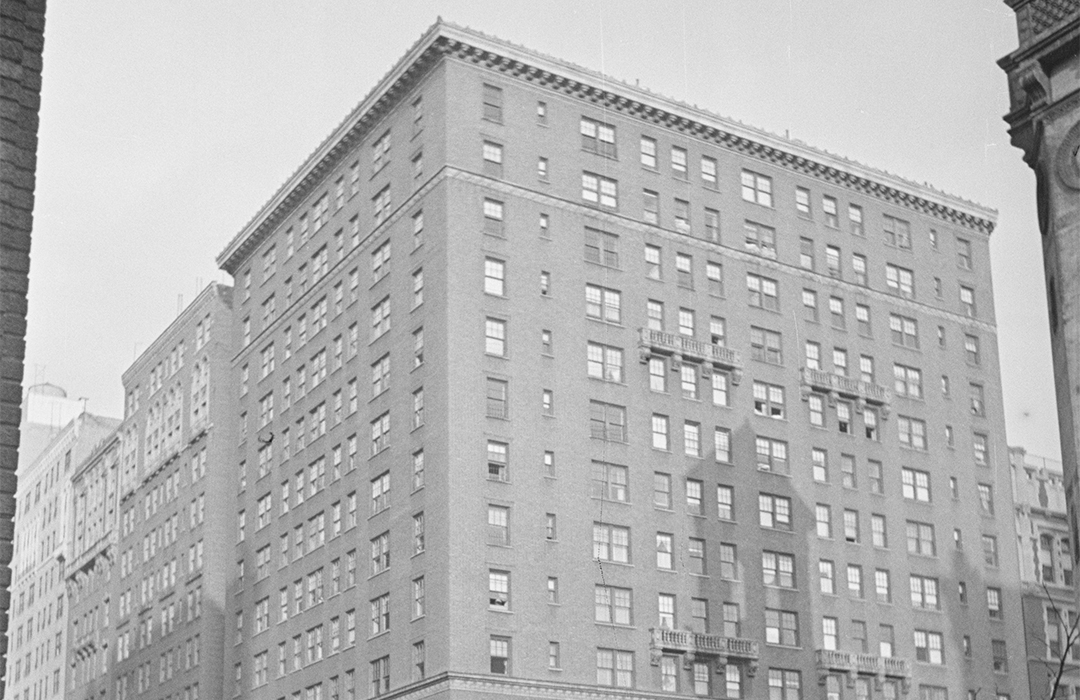
545 West End Avenue
by Tom Miller
Well known for his apartment houses, in 1924 George F. Pelham was commissioned by the Omaha Realty Company to design a 15-and-penthouse structure on the northwest corner of West End Avenue and 86th Street. Completed the following year, Pelham’s restrained neo-Renaissance structure was faced in tan brick above a two-story limestone base. The reserved ornamentation included intermediate cornices decorated with swags, and faux balconies wrought of terra cotta.
The building was targeted to a variety of tenants—from single occupants to families. An advertisement offered “3, 4, 5, 6, or 7 rooms” with “1, 2 or 3 baths.”
Prohibition had been in effect for several years when 545 West End Avenue opened. Among its early tenants, Max Marx, turned the law to an opportunity. On November 19, 1925, The New York Sun titled an article, “More Caught in Mail Rum Ring,” and reported that three women and six men had been arrested for operating a mail order liquor operation. Among those charged “with conspiracy to violate the prohibition law” was Max Marx.
Mrs. Anna Steinhardt, who lived here as early as 1930, was the wealthy widow of Benjamin Steinhardt. The Brooklyn Daily Times described her late husband as, “one of the leading attorneys of 20 years ago.” Anna, who lived here alone in her three-room apartment, was partially blind and rheumatic.
On the morning of February 8, 1931, the 70-year-old was cooking breakfast when “the gas flame ignited her robe,” according to the Brooklyn Daily Times. Her screams were heard by the superintendent, Joseph Welton, and a bellboy, William Fecht. They burst into the apartment to find her engulfed in flames. By the time physicians arrived, she had died.
Anna, who lived here alone in her three-room apartment, was partially blind and rheumatic.
Living here at the time was a sports celebrity, William C. Kelley, a quarterback with the Brooklyn Dodgers professional football team. His wife was the former Louise Ruhl. Born in Denver, Colorado, Kelley graduated from the University of Montana, “where he won renown as a quarterback and was known as ‘the Red Grange of the West,” according to The New York Sun. After playing with several organizations, he signed with the Brooklyn team in 1930. It was apparently a compatible relationship, and Kelley re-signed his contract in November 1931.
A few days later, following the afternoon game on November 14, the 29-year-old athlete “complained of feeling ill shortly after his return home,” reported The New York Sun. He died a few hours “after an attack of acute indigestion.”
Rents at the time ranged from $900 to $960 for three-room apartments, to $2,300 to $2,400 for seven-room suites. The most expensive would translate to about $4,550 per month in 2025.
Paying that pricey amount was Solomon Gelb, a 41-year-old who lived in the penthouse level. The Wichita Eagle described him as a “restaurateur, world traveler and luxury lover.” In the underworld, however, he was known as Sollie Gordon and, according to law officials, by ten other aliases. On December 2, 1938, Gelb was arrested by the Federal Treasury Department’s narcotic squad. The Department’s head, Major Garland Willliams, called Gelb, “the biggest importer in the country and one of the biggest dealers in the world. In the last five years he has brought several million dollars’ worth of narcotics into the United States.”
The Wichita Eagle reported that while Gelb “spent money with lavish abandon” and spent more than $2,000 a year for a penthouse that was “as fantastic as a dope fiend’s nightmare.” In the meantime, said the article, “his parents lived humbly in a Brooklyn basement apartment.”
Dr. Monroe A. Meyer, his wife Pearl, and their two daughters, Barbara, who was 13, and Eleanor, 8, lived here at least in 1938. A psychiatrist, Meyer graduated from Cornell University in 1916 and served as an assistant alienist at Bellevue Hospital until 1921. A member of several professional organizations, he was “prominently known in his profession,” according to The Daily Worker.
Dr. Meyer had traveled to Loyalist Spain in 1937. While he was in Valencia, the city was bombed several times. Ever the professional, upon returning to New York, he observed, “The nerves of women were stronger than the men’s. The latter were more upset by the bombardment than the women.”
Meyer contracted grippe (or influenza) early in 1939. His family said his illness had made him “melancholy.” On the morning of February 28, 1939, he wrote a note to Pearl that read, “Take care of yourself and the children. Love and good-bye.” He then carried out a bizarre method of suicide.
The New York Times reported that the doctor, “stabbed himself to death with an ice pick yesterday morning in the bedroom of his apartment at 545 West End Avenue at Eighty-sixth Street.” Because Meyers had an “extensive practice” and the family had no financial worries, police could not determine his motive, other than saying, “overwork may have been a contributing factor.”
Another resident who had organized crime ties was Alvin Jay Paris. Although the 28-year-old was officially an officer of a novelty company, he was described by the Herald and Review as “a self-styled ‘big bettor’ on athletic contests.” In plain language, he was a bookie.
On December 15, 1946, he was arrested on a “charge of bribery of a participant in a professional game and bookmaking.” Paris had attempted to “fix” the championship football playoff of the New York Giants and the Chicago Bears. He had allegedly offered $2,500 each to two Giants players to lose the game.
Sidney Meyer was a motion picture film director and producer.
Three days later, Judge Francis Valente denied bail to Paris. His decision was not because he feared Paris would jump bail, but because of information from high-ranking police officials. They told the judge, “That an attempt to kill Paris probably would be made by other gamblers if he were freed on $28,500 bail,” reported the Santa Rosa Republican. The judge told reporters, “The release of the defendant may be fraught with great danger to himself.” (In the end, Paris served less than a year before being released from prison.)
Sidney Meyer was a motion picture film director and producer. Active in progressive film work during the 1930s, The Daily World remarked on December 6, 1969, “Famous for his direction of the film ‘The Quiet One,’ Meyers also gained prominence as editor of a series of ground-breaking movies, including ‘The Savage Eye,’ on which he collaborated with Joseph Strick and Ben Maddow.” Meyer was living here when he died of cancer on December 4, 1969.
A renovation completed in 1970 reconfigured several of the apartments. It was most likely around this time that the building was christened The Florence, and the façade was restored. In reporting on façade repairs on vintage buildings in an article in The New York Times on January 8, 1894, journalist Lee A. Daniels commented on the efforts of the co-op board at 545 West End Avenue to preserve the building’s historic appearance. The article said, “The four balconies at the seventh and twelfth floors, of steel-reinforced fiberglass, are exact replicas of the original structures.” The project, according to co-op president Eli Gilbert, cost $25,000. He explained, “We all had seen plenty of buildings that had had balconies removed. We didn’t like the idea of scar tissue on ours.”
Because of the sympathetic treatment of the co-op owners, 545 West End Avenue has survived outwardly with little changed.
Tom Miller is a social historian and blogger at https://daytoninmanhattan.blogspot.com/


